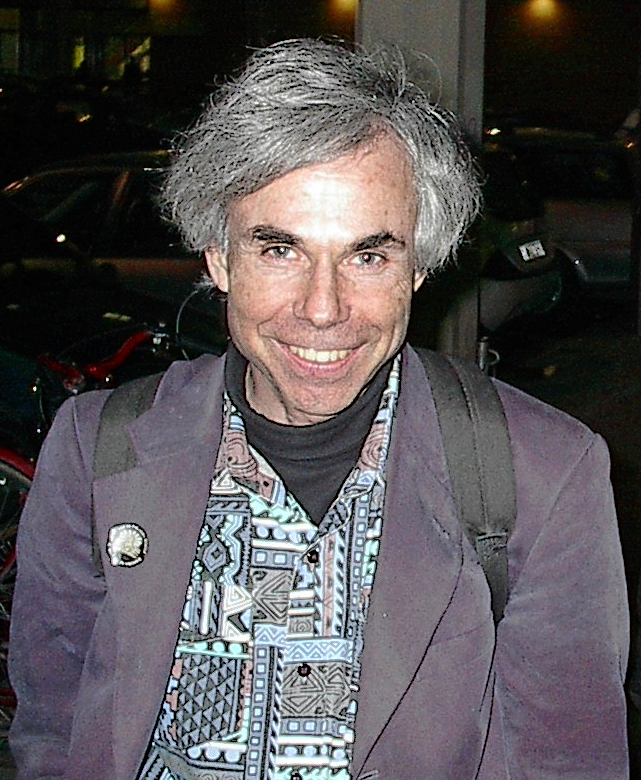|
Metamagical Themas
''Metamagical Themas'' is an eclectic collection of articles that Douglas Hofstadter wrote for the popular science magazine ''Scientific American'' during the early 1980s. The anthology was published in 1985 by Basic Books. The volume is substantial in size and contains extensive notes concerning responses to the articles and other information relevant to their content. (One of the notes—page 65—suggested memetics for the study of memes.) Major themes include: self-reference in memes, language, art and logic; discussions of philosophical issues important in cognitive science/AI; analogies and what makes something similar to something else (specifically what makes, for example, an uppercase letter 'A' recognizable as such); and lengthy discussions of the work of Robert Axelrod on the prisoner's dilemma, as well as the idea of superrationality. The concept of superrationality, and its relevance to the Cold War, environmental issues and such, is accompanied by notes on exper ... [...More Info...] [...Related Items...] OR: [Wikipedia] [Google] [Baidu] |
Douglas Hofstadter
Douglas Richard Hofstadter (born February 15, 1945) is an American scholar of cognitive science, physics, and comparative literature whose research includes concepts such as the sense of self in relation to the external world, consciousness, analogy-making, artistic creation, literary translation, and discovery in mathematics and physics. His 1979 book '' Gödel, Escher, Bach: An Eternal Golden Braid'' won both the Pulitzer Prize for general nonfiction"General Nonfiction" . ''Past winners and finalists by category''. The Pulitzer Prizes. Retrieved March 17, 2012. and a (at that time called The American Book Award) for Science. [...More Info...] [...Related Items...] OR: [Wikipedia] [Google] [Baidu] |
Memes
A meme ( ) is an idea, behavior, or style that spreads by means of imitation from person to person within a culture and often carries symbolic meaning representing a particular phenomenon or theme. A meme acts as a unit for carrying cultural ideas, symbols, or practices, that can be transmitted from one mind to another through writing, speech, gestures, rituals, or other imitable phenomena with a mimicked theme. Supporters of the concept regard memes as cultural analogues to genes in that they self-replicate, mutate, and respond to selective pressures. In popular language, a meme may refer to an Internet meme, typically an image, that is remixed, copied, and circulated in a shared cultural experience online. Proponents theorize that memes are a viral phenomenon that may evolve by natural selection in a manner analogous to that of biological evolution. Memes do this through the processes of variation, mutation, competition, and inheritance, each of which influences a meme's ... [...More Info...] [...Related Items...] OR: [Wikipedia] [Google] [Baidu] |
Martin Gardner
Martin Gardner (October 21, 1914May 22, 2010) was an American popular mathematics and popular science writer with interests also encompassing scientific skepticism, micromagic, philosophy, religion, and literatureespecially the writings of Lewis Carroll, L. Frank Baum, and G. K. Chesterton.Martin (2010) He was also a leading authority on Lewis Carroll. ''The Annotated Alice'', which incorporated the text of Carroll's two Alice books, was his most successful work and sold over a million copies. He had a lifelong interest in magic and illusion and in 1999, MAGIC magazine named him as one of the "100 Most Influential Magicians of the Twentieth Century". He was considered the doyen of American puzzlers. He was a prolific and versatile author, publishing more than 100 books. Gardner was best known for creating and sustaining interest in recreational mathematicsand by extension, mathematics in generalthroughout the latter half of the 20th century, principally through his "Mathema ... [...More Info...] [...Related Items...] OR: [Wikipedia] [Google] [Baidu] |
Egbert B
Egbert is a name that derives from old Germanic words meaning "bright edge", such as that of a blade. Anglo-Saxon variant spellings include Ecgberht () and Ecgbert. German variant spellings include Ekbert and Ecbert. People with the first name Middle Ages * Ecgberht of Kent, king of Kent (ruled 664–673) * Egbert or Ecgberht of Ripon (died 729), Anglo-Saxon saint, monk and Bishop of Lindisfarne * Egbert or Ecgbert of York (died 766), Archbishop of York * Ecgberht II of Kent (died c. 784), king of Kent * Egbert of Lindisfarne (died 821), Bishop of Lindisfarne * Egbert of Wessex, king of Wessex (ruled 802–839) * Ecgberht I of Northumbria, king of Northumbria (deposed 872; died 873) * Ecgberht II of Northumbria, king of Northumbria (ruled c. 876–883) * Egbert (archbishop of Trier) (c. 950–993) * Egbert of Liège (), educator and author * Egbert I, Margrave of Meissen (d. 1068) * Egbert II, Margrave of Meissen (c. 1060–1090) Later times * Egbert Bakker (born 1958), Dutch clas ... [...More Info...] [...Related Items...] OR: [Wikipedia] [Google] [Baidu] |
Peter Suber
Peter Dain Suber (born November 8, 1951) is a philosopher specializing in the philosophy of law and open access to knowledge. He is a Senior Researcher at the Berkman Klein Center for Internet & Society, Director of the Harvard Office for Scholarly Communication, and Director of the Harvard Open Access Project (HOAP). Suber is known as a leading voice in the open access movement, and as the creator of the game ''Nomic''. He shifted to half-time in July 2022. Education Suber graduated from Earlham College in 1973, received a PhD degree in philosophy in 1978, writing a dissertation on Søren Kierkegaard and a Juris Doctor degree in 1982, both from Northwestern University. Career Previously, Suber was senior research professor of philosophy at Earlham College, the open access project director at Public Knowledge, a senior researcher at Scholarly Publishing and Academic Resources Coalition (SPARC),. He is a member of the Board of ''Enabling Open Scholarship'', the Advisory Boards at ... [...More Info...] [...Related Items...] OR: [Wikipedia] [Google] [Baidu] |
Nomic
Nomic is a game created in 1982 by philosopher Peter Suber, the of which include mechanisms for changing those rules, usually beginning by way of democratic voting. The game demonstrates that in any system where rule changes are possible, a situation may arise in which the resulting laws are contradictory or insufficient to determine what is in fact legal. Its name derives from the Greek for "law", ('), because it models (and exposes conceptual questions about) legal systems and the problems of legal interpretation. Gameplay All aspects of Nomic are variable; the players can vote to change the rules to whatever sort of game they want to play. The initial was designed by Peter Suber, and was first published in Douglas Hofstadter's "Metamagical Themas" column in the June 1982 edition of ''Scientific American''. Hofstadter discussed Suber's book ''The Paradox of Self-Amendment'', in which Suber defined the game thus: Initially, gameplay occurs in clockwise order, with each ... [...More Info...] [...Related Items...] OR: [Wikipedia] [Google] [Baidu] |
Gestalt Psychology
Gestalt-psychology, gestaltism, or configurationism is a school of psychology that emerged in the early twentieth century in Austria and Germany as a theory of perception that was a rejection of basic principles of Wilhelm Wundt's and Edward Titchener's elementalist and structuralist psychology.Mather, George (2006) Foundations of Perception, Psychology Pressch.1 p.32 As used in Gestalt psychology, the German word ''Gestalt'' ( , ; meaning "form") is interpreted as "pattern" or "configuration". Gestalt psychologists emphasize that organisms perceive entire patterns or configurations, not merely individual components. The view is sometimes summarized using the adage, "the whole is more than the sum of its parts." Gestalt psychology was founded on works by Max Wertheimer, Wolfgang Köhler, and Kurt Koffka. Origin and history Max Wertheimer (1880–1943), Kurt Koffka (1886–1941), and Wolfgang Köhler (1887-1967) founded Gestalt psychology in the early 20th century. The domi ... [...More Info...] [...Related Items...] OR: [Wikipedia] [Google] [Baidu] |
Lisp Programming Language
Lisp (historically LISP) is a family of programming languages with a long history and a distinctive, fully parenthesized prefix notation. Originally specified in 1960, Lisp is the second-oldest high-level programming language still in common use, after Fortran. Lisp has changed since its early days, and many dialects have existed over its history. Today, the best-known general-purpose Lisp dialects are Common Lisp, Scheme, Racket and Clojure. Lisp was originally created as a practical mathematical notation for computer programs, influenced by (though not originally derived from) the notation of Alonzo Church's lambda calculus. It quickly became a favored programming language for artificial intelligence (AI) research. As one of the earliest programming languages, Lisp pioneered many ideas in computer science, including tree data structures, automatic storage management, dynamic typing, conditionals, higher-order functions, recursion, the self-hosting compiler, and the read� ... [...More Info...] [...Related Items...] OR: [Wikipedia] [Google] [Baidu] |
Ambigram
An ambigram is a calligraphic design that has several interpretations as written. The term was coined by Douglas Hofstadter in 1983. Most often, ambigrams appear as visually symmetrical words. When flipped, they remain unchanged, or they mutate to reveal another meaning. "Half-turn" ambigrams undergo a point reflection (180° rotational symmetry) and can be read upside down, mirror ambigrams have an axial symmetry and can be read through a reflective surface (like a mirror or a mirroring lake), and many other types of ambigrams exist. Ambigrams are found in different languages, various alphabets and the notion often extends to numbers and other symbols. It is a recent interdisciplinary concept, combining art, literature, mathematics, cognition, and optical illusions. Drawing symmetrical words constitutes also a recreational activity for amateurs. Numerous ambigram logos are famous, and ambigram tattoos have become increasingly popular. There are methods to design an ambig ... [...More Info...] [...Related Items...] OR: [Wikipedia] [Google] [Baidu] |
Gödel, Escher, Bach
''Gödel, Escher, Bach: an Eternal Golden Braid'', also known as ''GEB'', is a 1979 book by Douglas Hofstadter. By exploring common themes in the lives and works of logician Kurt Gödel, artist M. C. Escher, and composer Johann Sebastian Bach, the book expounds concepts fundamental to mathematics, symmetry, and intelligence. Through short stories, illustrations, and analysis, the book discusses how systems can acquire meaningful context despite being made of "meaningless" elements. It also discusses self-reference and formal rules, isomorphism, what it means to communicate, how knowledge can be represented and stored, the methods and limitations of symbolic representation, and even the fundamental notion of "meaning" itself. In response to confusion over the book's theme, Hofstadter emphasized that ''Gödel, Escher, Bach'' is not about the relationships of mathematics, art, and music—but rather about how cognition emerges from hidden neurological mechanisms. One point in the ... [...More Info...] [...Related Items...] OR: [Wikipedia] [Google] [Baidu] |
Cold War
The Cold War is a term commonly used to refer to a period of geopolitical tension between the United States and the Soviet Union and their respective allies, the Western Bloc and the Eastern Bloc. The term '' cold war'' is used because there was no large-scale fighting directly between the two superpowers, but they each supported major regional conflicts known as proxy wars. The conflict was based around the ideological and geopolitical struggle for global influence by these two superpowers, following their temporary alliance and victory against Nazi Germany and Imperial Japan in 1945. Aside from the nuclear arsenal development and conventional military deployment, the struggle for dominance was expressed via indirect means such as psychological warfare, propaganda campaigns, espionage, far-reaching embargoes, rivalry at sports events, and technological competitions such as the Space Race. The Western Bloc was led by the United States as well as a number of other First W ... [...More Info...] [...Related Items...] OR: [Wikipedia] [Google] [Baidu] |






.png)